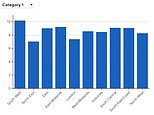Ambulances are failing to meet response time targets for potential heart and stroke victims in all but one local authority in England, damning figures reveal.
Paramedics should arrive at the scene of these calls within 18 minutes, but some time-critical patients are forced to wait more than a day.
Windsor and Maidenhead was the only one of 194 areas to meet the target for ‘Category 2’ calls last year, with an average time of just over 16 minutes.
Cornwall performed the worst, with an average wait of 1 hour and nine minutes, almost four times longer than it should take.
This was followed by patients in West Devon, who had an average wait of just over an hour, and South Hams with an average wait of 59 minutes.
The figures were obtained by the Liberal Democrats, who sent freedom of information requests to all ten ambulance trusts in England.
The party warned that patients are being “left to suffer unnecessarily” and can no longer rely on an ambulance arriving in time for a loved one in their time of need.
In one alarming case, a patient in Warrington waited 25 hours and 40 minutes for an ambulance to arrive after a Category 2 call – 85 times longer than the 18-minute target.
Other long waits included a delay of 25 hours and 27 minutes in Staffordshire and Stoke on Trent and 22 hours and 52 minutes in East Lancashire.
Additionally, 173 of the 194 areas did not meet the seven-minute response time target for life-threatening ‘Category 1’ calls, where a patient’s heart has stopped or they are not breathing.
Mid Devon and West Devon had the worst average response times for Category 1 calls, both doubling the target of seven minutes.
Worryingly, one patient in Oldham waited 11 hours and 44 minutes for an ambulance to arrive for a Category 1 call.
In the 165 areas that provided complete data, nine in ten reported an increase in average ambulance response times for Category 2 calls since 2019.
In thirteen areas the average response time more than doubled during this period, with the sharpest increase of 141 per cent in Plymouth.
Waits had increased from 24 minutes to 57 minutes.
Daisy Cooper, Liberal Democrat health and social care spokesperson, said: “Calling an ambulance when you or a loved one is in a serious emergency is one of the most distressing times in someone’s life.”
‘The least people deserve is to know that an ambulance will be able to get to them in time. Unfortunately, all too often that doesn’t happen, as these devastating numbers demonstrate.
‘This Conservative government has overseen the complete decimation of local NHS services.
‘Under the Conservative Party, the health service has faced unforgivable neglect and patients are hardest hit.
‘We urgently need investment in our ambulance services. For too long staff have not received the resources they need and patients have suffered unnecessarily.’
Rory Deighton, director of the NHS Confederation’s acute care network, blamed the slow flow of patients through A&E for contributing to long waits, as ambulance crews were unable to drop off patients promptly or respond to new calls.
He said there had been recent improvements, adding: ‘Health leaders know ambulance services are under enormous pressure.
‘Call handlers are receiving an increasing number of calls, including those that are life-threatening or emergency, while ambulance crews and their colleagues in emergency departments are working together to tackle long delays in deliveries to hospitals.
“Ambulance leaders know there is a long way to go to meet response goals and are working incredibly hard to ensure the improvements we are seeing are sustained over the long term.”
A Department of Health and Social Affairs spokesperson said there had been “significant improvements” in ambulance response times this year.
They added: “We have committed an additional £200 million last year, along with new ambulances, to further expand capacity and improve response times, and the Government is providing the NHS with record funding of almost £165 billion a year to end of this Parliament, along with a record number of doctors and nurses.

